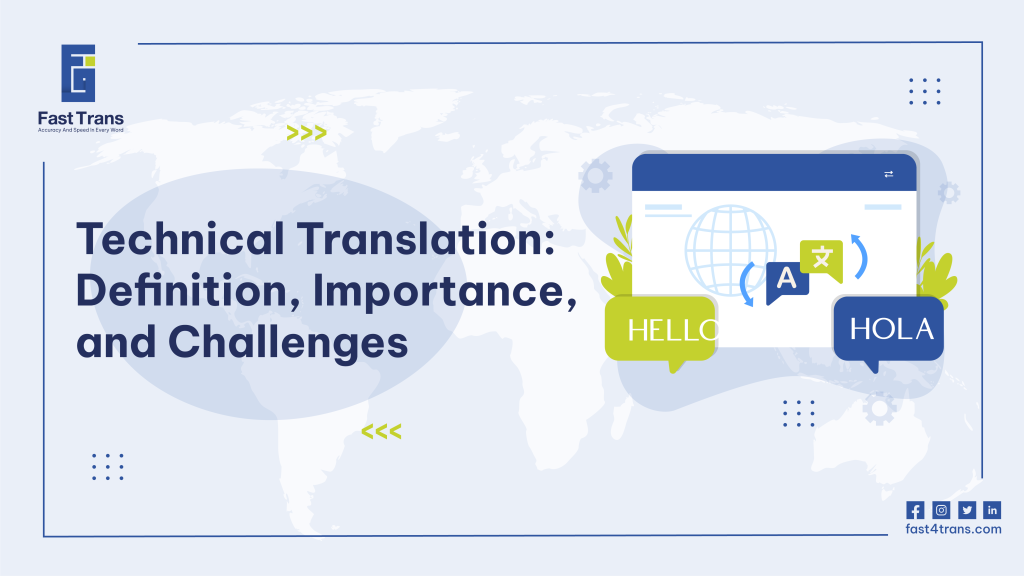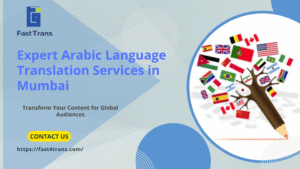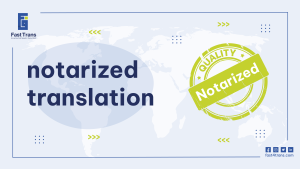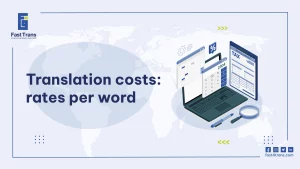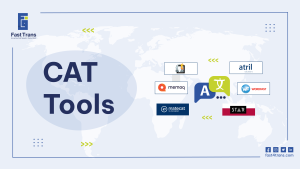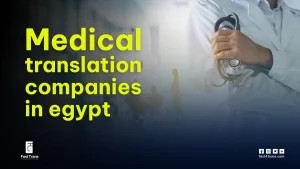Arabic technical translation is a specialized service that ensures complex, industry-specific content—like user manuals, patents, and scientific papers—is accurately conveyed to Arabic-speaking audiences. This field demands a deep understanding of both technical jargon and cultural nuances to ensure precision in sectors like healthcare, engineering, and aerospace.
By combining expert human translation with advanced tools like Translation Management Systems, businesses can meet legal standards, improve international collaboration, and ensure clear communication in a rapidly expanding Arabic market.
What is Arabic Technical Translation?
Arabic technical translation refers to translating texts that require knowledge of a specialized field, such as science, engineering, technology, aerospace, pharmaceuticals, manufacturing, healthcare, and more, into Arabic. This requires not only excellent translation skills but also a deep understanding of the specific jargon and terminology of the relevant field in Arabic.
For instance, translating a scientific academic paper into Arabic demands an advanced awareness of the scientific vocabulary and concepts, while simple medical content may not require as much specialized knowledge.
The need for Arabic technical translation has grown significantly, as businesses expand globally and Arabic-speaking markets continue to develop. Technical language can be found everywhere—from software applications and user guides to knowledge bases and academic journals—often requiring precise and culturally appropriate translations.
Overall, the demand for Arabic technical translation is higher compared to other types of translation, yet the supply of qualified Arabic-speaking technical translators remains limited. This field is time-consuming, requires impeccable accuracy, and presents unique challenges and opportunities for growth.
Who can need technical translation services?
Technical translation services are essential for industries like manufacturing, technology, healthcare, legal, and energy to ensure accurate communication of complex documents across multiple languages. This helps businesses and organizations maintain safety, compliance, and efficiency in global operations.
1. Manufacturers and Engineers
Companies involved in the production of machinery, equipment, or complex systems often require technical translation services to ensure their user manuals, instruction guides, safety regulations, and technical specifications are accurately conveyed in multiple languages. These translations need to preserve the integrity of highly specific terms and instructions to guarantee that global customers can operate and maintain products correctly and safely.
2. Technology and Software Developers
The tech industry is a major consumer of technical translation services, especially when it comes to localizing software, mobile applications, and websites. This requires translating source code-related documentation, user interfaces, software updates, and troubleshooting guides. In this field, mistranslations or errors can result in software malfunctions, user dissatisfaction, or even legal complications, making precise and context-aware translations essential.
3. Medical and Pharmaceutical Companies
The healthcare sector, including pharmaceutical companies, medical device manufacturers, and healthcare providers, often requires technical translations for a variety of documents. These include clinical trial reports, medical device instructions, regulatory submissions, and patient information leaflets. Given the importance of accuracy and safety in this sector, professional medical translations ensure that critical information is conveyed without error, complying with local regulations and preventing potential health risks.
4. Legal Professionals
In industries governed by strict legal standards, like patent law or international trade, legal professionals require precise translations of technical documents. This includes patent applications, contracts, standards compliance documents, and more. A mistranslation in these contexts could lead to serious legal consequences, making technical translation services indispensable.
5. Energy and Environmental Firms
The energy and environmental sectors involve complex technical documentation, such as safety reports, project proposals, environmental impact assessments, and regulatory compliance documents. Whether a company is involved in oil, gas, renewable energy, or sustainability projects, translating these documents with precision is crucial to ensure that all involved parties are on the same page, especially when dealing with international regulations.
6. Aerospace and Aviation Industry
In the highly regulated aerospace and aviation industry, technical translations are required for maintenance manuals, safety procedures, aircraft specifications, and flight operation protocols. These translations must adhere to stringent industry standards to ensure air travel safety and compliance with international aviation regulations.
7. Automotive Industry
Automotive manufacturers, parts suppliers, and dealerships rely on technical translations for everything from assembly instructions and vehicle manuals to safety standards and advertising materials. Accuracy is key when translating complex automotive technology, engineering schematics, and performance metrics to ensure global markets understand how to properly use and maintain vehicles.
8. Scientific Researchers
Researchers and scientists often collaborate across borders, and for this collaboration to be effective, technical translations are required for research papers, scientific journals, lab reports, and conference materials. This ensures that new scientific developments, discoveries, and innovations can be shared and understood worldwide, fostering global collaboration and advancement in various fields.
9. Academic Institutions
Universities and research organizations with international students, faculty, and collaborative programs often need technical translation services for educational materials, academic papers, technical reports, and curriculum content. These services ensure that academic knowledge is accessible to non-native speakers, supporting global learning and research endeavors.
10. Government and Regulatory Agencies
Government bodies and regulatory agencies involved in overseeing industries such as construction, telecommunications, transportation, and energy require technical translations to make sure that regulatory documents, technical standards, and guidelines are understood by international stakeholders. This is particularly important when enforcing compliance across different countries and cultures.
Why Arabic technical translation matters?
Being essential for all industries; Technical translation is vital because businesses need quality translation for their documents with Technical translation is essential for businesses targeting the Arabic-speaking market, whether it’s patents, user manuals, or safety instructions.
1. Compliance and Legal Requirements:
Many businesses may underestimate the importance of Arabic technical translation, assuming they can bypass it. However, for companies aiming to meet international standards and regulatory requirements, especially in Arabic-speaking countries, accurate technical translation is crucial. Without it, businesses risk legal and compliance issues that can hinder their growth in the region.
2. Facilitating International Collaboration:
Arabic technical translation enables businesses to effectively communicate with Arabic-speaking partners, stakeholders, and clients. This ensures smoother international collaboration and fosters better relationships within the global market.
3. Accuracy:
Since technical documents often contain industry-specific jargon and intricate information, accurate Arabic technical translation is vital to ensure that the language is not only clear and understandable to the Arabic audience but also preserves the original intent and technical precision.
4. Quality:
In sectors like aerospace, pharmaceuticals, and engineering, where technical accuracy is paramount, Arabic technical translation ensures that key documents maintain the highest quality and consistency. An experienced Arabic technical translator is indispensable in ensuring that every detail is correctly conveyed, minimizing the risk of errors and improving the overall product or service quality in the Arabic market.
Types of Arabic Technical Translation
Types of Arabic Technical Translation vary across various fields. Technical documents that support a medical manufacturing process, for example, will differ in format and subject matter from the documentation of a software development project, even when translated into Arabic. Understanding these distinctions is key to delivering accurate and culturally appropriate translations.
1. User Manuals:
This is likely one of the most common types of technical translation, and it is essential for businesses aiming to provide customer satisfaction in the Arab market. A technical translator working on a user guide doesn’t just translate text; they must also localize the entire document, adapting it to Arabic cultural preferences and making sure it’s easily understood by Arabic-speaking users.
2. Patents:
Patents ensure the protection of intellectual property, and when translating them into Arabic, precision is critical to maintain the integrity of the creator’s rights. In the Arabic-speaking world, patents play a vital role in securing intellectual property across international borders and supply chains.
3. Production Handbooks:
These are similar to user manuals but are specifically tailored for employees and workers. In the context of Arabic translation, it’s essential to adapt these handbooks not just linguistically but also culturally, ensuring that Arabic-speaking workers clearly understand quality control and production processes.
4. eLearning Videos and Courses:
Localizing technical training materials into Arabic involves adapting and translating content for employees or trainees. This requires careful attention to the Arabic language’s specific nuances to ensure the message is clear and the content is accessible to Arabic speakers.
5. User Research:
User research is critical for businesses’ growth, and its translation into Arabic ensures that findings and insights are communicated accurately to Arabic-speaking stakeholders, enabling businesses to cater to regional preferences and behaviors.
6. Contract Translation:
While contract translation often overlaps with legal translation, technical precision is still paramount. Even in Arabic translations of contracts and reports, the terminology must be handled with care to maintain clarity, accuracy, and compliance.
7. Maintenance Manuals:
These documents, which include information about machinery and its setup, must be carefully translated into Arabic to ensure that Arabic-speaking technicians can follow the instructions accurately.
8. Scientific, Engineering, and Technical Articles:
Educational content, whether academic or not, that requires specialized knowledge in a particular field is also considered technical translation. For Arabic, this means translating complex terminology and ensuring that the technical content is understandable for Arab professionals or students.
The scope of Arabic technical translation is vast and can also include the following types:
- Articles on manufacturing and engineering topics
- Safety data sheets
- CAD Drawing translation
- Compliance documents
- Product labels and catalogs
- Technical studies and reports
- Educational textbooks
- Website localization
How Arabic Technical Translation works?
As mentioned earlier, an Arabic technical translator must be highly familiar with the specific jargon and terminology of their specialized field, along with their professional translation skills. In this section, we explore how Arabic technical translation can be handled by the translator alone or enhanced by technological tools.
1. Human Translation
Human translation is crucial for localization and ensuring accuracy, especially when avoiding contextual errors or ambiguity in Arabic, which has its own unique syntactic, semantic, and cultural structures. However, available Arabic technical translators might need more time, effort, and cost to complete a project, especially considering the competitive nature of the Arabic technical translation market.
2. Machine Translation & Machine Translation Post Editing (MTPE)
While machine translation and its tools are not intended to replace human translators, they significantly speed up the process, making it more cost-effective for Arabic technical translation as well. Tools like Google Translate or specialized Arabic translation engines are often used in conjunction with human effort.
Arabic technical translation can also benefit from translation memories (TM) and Automated Quality Assurance tools, ensuring consistency, especially when translating highly technical Arabic terms and maintaining accuracy across various dialects or regional differences.
MTPE combines human and machine translation, allowing the machine to handle the more routine tasks, while a human linguist or Arabic translator/editor reviews and refines the output, ensuring the final translation is culturally and technically precise.
3. Preparing for Translation
On the client or company side, thorough project preparation and market research are essential. Whether translating an Arabic manual, user guide, or online content, much of the quality of the target Arabic translation depends on the quality of the original source text.
Additionally, it may be necessary to provide references and clarify the tone of voice intended for the Arabic-speaking audience before the translator begins the project. This ensures that the translation meets both linguistic and cultural expectations.
Traits of a Technical Translator
- Up to date with field jargon and terminologies
- A great researcher
- Has an eye for detail: this comes in handy with dealing with technical documents that contain lots of numbers.
- Interdisciplinarity: because technical translation in its essence requires knowledge of different fields like law, or economy, and often intersects with other types of translation like legal or medical.
- Uses Computer Assisted Translation (CAT) tools.
- Great command of cultural nuances in his or her language pair.
- Aware of technical abbreviations, jargon, and acronyms.
- Keeps a glossary of terminology to improve consistency throughout.
Technical translation vs Literal translation
Technical translation and literal translation are two different approaches.
The former focuses on accuracy in delivering specialized content. As mentioned above, it caters to medical, engineering, manufacturing, aerospace, and content of the like.
The main task of a technical translator is to deliver the exact meaning of the source text to the target readers, in doing so, they can paraphrase, or reword to simplify the highly technical and specialized language.
Moreover, the process of technical translation involves localization and rendering Cultural contexts and nuances.
However literal translation is quite different from this because it only focuses on a word-for-word translation. You can think of it in the same manner as Google Translate because it takes it word-for-word with little contextualization.
Although Literal translation could be sometimes associated with negative connotations, meaning a poorly translated text, it’s needed for a specific audience. Choosing between technical or literal translation depends on the audience, the source text, and many other factors.
Literal translation also could work well with texts that do not need any kind of localization like a source text written in a simple language.
Common Technical Document Translation Materials
Like other translation fields, technical translation is not always plain written text that needs to be translated, the source material itself could come in different shapes, and tone of voice.
We have already mentioned patents, Patents refer to copy and ownership rights, and they have their own way of being written or translated.
For instance, they must comply with each country’s requirements. It is meant to give credit to the person without revealing information about their product. Therefore, a patent translator needs to be careful with that.
Software strings
Another type of material is Software Strings. It is entirely different from patents.
Software string translation or localization might require the translator to work on coding formats like resx, or Java properties. They are also required to provide context for each string.
It is a highly technical process that involves lots of testing to make sure that the user interface is accurately localized.
The key challenges in Arabic technical translation
- Knowledge of terminology
- Always staying up to date with new emerging technologies that will require new terminology.
- Localization challenges for each target audience.
- Abbreviations
- Attention to digits and numbers.
- Terminology related to new technologies.
- Complex documents with graphs, figures, numbers, and calculations in addition to technical text.
- A mixture of specializations is required, such as legal, aviation, engineering, etc.
- Complex document structures.
- In the case of intellectual property rights (IPR) patents that we mentioned above, translators need to master a very specific and highly regulated language.
- Challenges with layout because the word density could increase or decrease from one language to another in the translation process.
- The simplest error could result in penalties, fines, or even lawsuits.
How localization technology can streamline technical translation
We’ve discussed the recurrent challenges of technical translation. In this section, we’ll have a look at how to make those challenges easier with the help of technology.
Localization technology in its broad sense refers to different tools and resources that are present online in the form of web, desktop software applications, or mobile applications, all of which make translation a smoother experience.
Starting with Translation Management Systems (TMS) that help in automating the process of translation, and organizing tasks. You can think of CAT tools that have Translation Memory (TM) which is the part responsible for automating repetitive tasks. You can also think of TMS as encompassing Quality Assurance, and Machine Translation tools.
How is this TMS beneficial for technical translation?
-Automating repetitive tasks like extracting the content only out of the technical source text.
-Aids in consistency because it keeps a reservoir of all important technical terminologies.
-Notices what the human eye fails to notice: (typos, grammatical errors, numbering…etc.) by running automated quality assurance.
-Combining the best of the two worlds because it allows for machine intervention next to the expertise of the human translator.
How Fast Trans helps with technical translation?
Are you looking for professional technical translators with years of experience to assist you with translating technical documents?
Fast Trans offers technical translation services among other array of translation services. This ranges from safety manuals, user guides, and machinery specifications to other large technical projects. In doing so, Fast Trans team are checking all of the four necessities: speed, professionalism, accuracy, and affordability, depending on a great time working round the clock to satisfy the huge demand for technical translations.
What Our Customers Say
Since the translation project is theirs, we encourage the clients to discuss every stage of the process.
You can check our clients’ comments for yourself at Google Reviews.
Conclusion
Arabic technical translation is a specialized field that involves translating complex and industry-specific content into Arabic. This includes areas like engineering, healthcare, manufacturing, pharmaceuticals, and more, requiring a deep understanding of both the language and specialized jargon. Accurate translation in this sector is crucial, as it ensures that critical information such as user manuals, patents, and scientific papers are communicated clearly and correctly to Arabic-speaking audiences. This is particularly important for industries that depend on precise terminology, such as aerospace or medical fields, where any miscommunication could have significant consequences.
The importance of Arabic technical translation lies in its role in supporting global business expansion, legal compliance, and international collaboration. It enables companies to meet regulatory standards and communicate effectively with Arabic-speaking stakeholders. The process involves not only linguistic expertise but also an understanding of cultural nuances and industry-specific terminology. While traditional human translation is essential for maintaining accuracy, technology tools such as machine translation and Translation Management Systems (TMS) can help streamline the process, ensuring consistency and efficiency across various technical materials.

